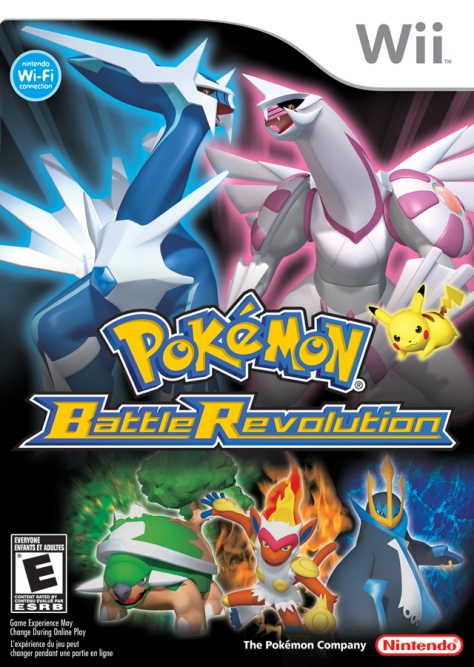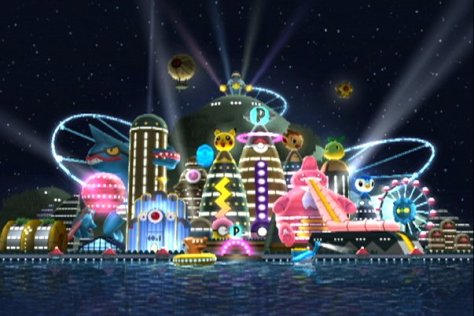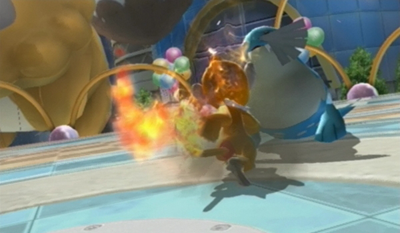
I’ve done it! My original stated intention has been fulfilled! Continue reading Pokemon: A Grand Ambition, Update 7 – The End?

I’ve done it! My original stated intention has been fulfilled! Continue reading Pokemon: A Grand Ambition, Update 7 – The End?
 Having done a little bit of reading on Pokémon Battle Revolution before playing it, I tempered my expectations. Its predecessors, specifically on the GameCube, featured drastic changes to the Pokémon formula, while still maintaining the foundations of what a Pokémon game was. And, Genius Sonority was successful in creating full-fledged console Pokémon games after many years of fans wanting them. This game had none of that ambition. Or at least, none of their ambition went towards a single-player component, which was all I was interested in. Because of this, and because I was such a latecomer, I found the game to be very disappointing.
Having done a little bit of reading on Pokémon Battle Revolution before playing it, I tempered my expectations. Its predecessors, specifically on the GameCube, featured drastic changes to the Pokémon formula, while still maintaining the foundations of what a Pokémon game was. And, Genius Sonority was successful in creating full-fledged console Pokémon games after many years of fans wanting them. This game had none of that ambition. Or at least, none of their ambition went towards a single-player component, which was all I was interested in. Because of this, and because I was such a latecomer, I found the game to be very disappointing.

Instead of a full-fledged story, this game features a set of colosseums. These pit the player against a barrage of opponents, battling in a style unique to the venue. Each colosseum featured a unique rule set, although many were very similar. The rule sets affected the progression structure and the battle style. Many new battle styles were introduced in this game too, or at least, introduced to me. As I felt with Colosseum and Gale of Darkness, the double battles were a high point for this game. In that case, the low point would undoubtedly be the Neon Colosseum which introduced Fortune Battles.
In Fortune Battles, both trainers’ parties were input onto a spinning wheel, and they chose by shooting Poké Balls at it, like darts. Until I got the timing down (I spent two of my twelve hours on this single colosseum) it was maddening. Getting stuck with my opponent’s shoddy Pokémon was difficult enough, but having to restart after making it all the way to the leader? Now that was infuriating! However, most of the colosseums were cakewalks – this was a very easy game with imported Pokémon. After overtaking the leaders of the eleven colosseums, I had my Surfing Pikachu and was content. Replaying yielded new costumes for my avatar, but that wasn’t my bag.

It may have been more of a draw when the online was still… well, online. With the Nintendo Wi-Fi Connection now offline, that whole component is nonexistent. Of course, the game also features a robust local multiplayer mode, with support for all generation IV titles, but truthfully, I haven’t tried that yet. I’m looking forward to it though for two reasons. Being able to use the DS as a wireless controller is fantastic and it should allow for more cinematic battles (relegating all or most of the user interface to that system). Also, having the announcer return from his absence in the GameCube games is great! It reminds me of Pokémon Stadium on the N64; plus he’s helping learn the “correct” pronunciation of a few Pokémon!
Ultimately, I think I know why the single-player component of this game was so lackluster. Its release date tells the story. It was released in North America in June 2007 – two months after Diamond/Pearl released, and about six months after the Wii did. More telling though is its Japanese release date – a mere two weeks after the Wii. For all intents and purposes, this game was launch window. I expect Genius Sonority didn’t have the luxury of a lengthy development time. For Colosseum, they probably had a year-and-a-half development time, while Gale of Darkness may have had upwards of two years.

Also, in a potentially cramped development window, they had to develop for a new platform which featured improved visuals and fewer limitations on storage, implement compatibility with the Nintendo DS and the generation IV games, and perhaps the biggest hurdle for them was the integration of online play. This was only their fourth title, and their first to include any online functionality. Granted, they are closely affiliated with Nintendo and undoubtedly received much support, but Nintendo wasn’t so sharp in that regard at that time either (and many would say they still aren’t!). I imagine just getting the game out was an accomplishment in itself, but as it is, it’s an entirely skippable release, unless you’re like me and NEED THAT SURFING PIKACHU!!!
 A retread of the region of Sinnoh, Pokémon Platinum is an enhanced remake of Diamond and Pearl – the fourth generation of Pokémon games and the ones that ushered in the era of the Nintendo DS. Released in the spring of 2009, two years after its predecessors, it’s a game that I never played until now. Nonetheless, the remake sticks so closely to its predecessors that little feels unfamiliar. Like everything before it, it’s a solid entry that refines the classic formula but does little to improve upon it.
A retread of the region of Sinnoh, Pokémon Platinum is an enhanced remake of Diamond and Pearl – the fourth generation of Pokémon games and the ones that ushered in the era of the Nintendo DS. Released in the spring of 2009, two years after its predecessors, it’s a game that I never played until now. Nonetheless, the remake sticks so closely to its predecessors that little feels unfamiliar. Like everything before it, it’s a solid entry that refines the classic formula but does little to improve upon it.

As I did with Emerald, I started in an uncommon way. Thanks to owning multiple handhelds and games, I was able to start with all three starters. Not only that, since some were traded, they earned 1.5x experience and leveled faster than normal. Due to this, the difficulty ranged from pushover to frustrating. At points, my Pokémon would grow too strong and would only listen to me occasionally. This was very frustrating! About four gym leaders in (out of eight) this wasn’t much of a concern anymore. The only other time I had issues was facing the Elite Four. Conquering them required grinding – but it seemed like less compared to Emerald.

This generation introduced many new features, although for my purposes, there’s little that I wanted to, or could, interact with. Arguably the biggest feature was the introduction of online trading and battling. With the Nintendo WFC shutdown now, this is a nonstarter though. The next most important introduction would probably be the use of the touch screen via the Pokétech. Consisting of twentyish apps, the majority of them are useless novelties. This was the biggest lost opportunity. Naturally, there were more Pokémon introduced and many more gameplay additions and tweaks too.
If the poor use of the touch screen was the biggest lost opportunity, perhaps the second would be the lackluster visuals. The environments – routes, dungeons, and towns – are set on 2D backgrounds, but for the first time, use 3D accents. Buildings, trees, and other objects are displayed in such a way that they pop up and out visually. Battles however, still show off the battling Pokémon in flat 2D drawings that offer little animation. There’s probably more fidelity than in previous games, but it’s hard to tell.

Being three mainline games into my Grand Ambition at this point, it’s very easy for the games to run together and seem less distinct. With the major new addition to the series obsolete today, Pokémon Platinum had little to offer in newness. The most enticing new feature was the Pokémon themselves. Going back and capturing the Pokémon that I did back in high school was a comforting task. Sinnoh wasn’t as memorable a region for me as Hoenn was, but it was still nice to go back. This, despite the fact that most of the additions were either poor or unused by me, as I focused nearly solely on beating the game and capturing the legendaries.
 I swear, I’m so bad about keeping the internet updated on my Pokémon goings-on! How does anyone manage to go on with their day-to-day life, not knowing what I’m doing in the Pokémon video games? Serious kudos’ are in order for all who’ve had to suffer these past three (!) months without a grand ambition update. It’d help me out if I update more frequently, I mean, look at that title! I’ve got a lot to discuss so I’ll get down to it.
I swear, I’m so bad about keeping the internet updated on my Pokémon goings-on! How does anyone manage to go on with their day-to-day life, not knowing what I’m doing in the Pokémon video games? Serious kudos’ are in order for all who’ve had to suffer these past three (!) months without a grand ambition update. It’d help me out if I update more frequently, I mean, look at that title! I’ve got a lot to discuss so I’ll get down to it.
Okay, the first major happening since I last wrote about my grand ambition was my completion of Pokémon XD: Gale of Darkness. I completed it to the moon and back! Nearly, that is. I was able to snag and extract every available shadow Pokémon, caught most of the limited wild Pokémon, and obtained every in-game trade Pokémon – which included a Shuckle! Honestly, the only thing that I didn’t do was complete the Orre Colosseum. It hosted a difficult series of trainers that wasn’t unavailable until after completing the game. I participated in the first round so I could obtain a Lucky Egg – an experience duplicating held item which is very valuable. Having extracted all of the Pokémon, I have shelved Gale of Darkness.
Before diving into Pokémon Platinum, as I had planned, I took a detour. One late night, partially at the heckling behest of a friend, I purchased the WiiWare title My Pokémon Ranch. What a great mediocre poor way to spend ten dollars buy a Mew. Here’s how this software (not a game, folks!) works: players connect their Nintendo DS and either Diamond or Pearl and transfer Pokémon to the ranch. It stores up to 1,200 Pokémon and acts more like a gussied up utility. After depositing 999 Pokémon, players are awarded with a Mew. Believe me, this was no small task and was so gratifying. My friend can attest to that fact as well.
So, after spending hours catching low-level Bidoof and Starly in Diamond, I finally transitioned to Platinum. Side note: I didn’t spend any other time playing Diamond – this has all my creatures from back in the day and I didn’t want to sully this game, yet. At this point, I’ve completed Platinum. In the sense that I’ve beaten the Elite Four; I still haven’t seen all the post-game content that opened up afterwards, so I’m not satisfied with being done with it. In fact, I said to myself that I wasn’t going to catch all available Pokémon in it, and briskly move onto Battle Revolution, but I’m swaying the other way recently. So I may wind up catching all the Pokémon I can in the game. Mind you, I don’t mean obtain one of everyone – simply catch anything that’s out in the wild.
Once I’m satisfied with Platinum, I’ll begin Battle Revolution on the Wii. That should be a succinct adventure as there are only three extractable Pokémon – a Magmortar, Electrivire, and a Pikachu that knows Surf. Perhaps, I’ll play a Pokémon Ranger game or two? I need to do more research towards extracting legendary Pokémon from those games. Depending yay or nay, I should transition to HeartGold, which I’m excited to play again and hopefully complete all post-game content. Until next time!

I’ve been playing a lot of Pokemon HeartGold in my free time lately. One thing that I like about it is the user interface. Because it’s on the Nintendo DS it can take advantage of the system’s touch screen. Now you think it working fine would be a no-brainer. A menu heavy role-playing game on a system with a touch screen should work well, and HeartGold does. I guess my whole point in bringing this up is because of how little Game Freak utilized the touch screen in Pokemon Diamond/Pearl.
In that generation of Pokemon games the touch screen was used terribly outside of battles. The normal action took place entirely on the top screen while occupied on the bottom screen were twenty or so mostly useless doodads. The bottom screen was a Swiss Army knife of crap. Navigation of menus could sometimes be done through the bottom screen, but the icons were so small and positioned as to be nearly useless. On the other hand, the bottom screen was utilized well in battles.
In battle there were four options. Instead of the prompts being of equal size and therefore of equal importance, the battle option was very prominent. After selecting it, the next choices are what moves to use and these are evenly divided between a Pokemon’s four options; even when using an item or switching to another Pokemon in battle, the user interface is easy to use.
HeartGold makes no improvements of the user interface in battles but menus outside of battles are totally revamped. In HeartGold (and SoulSilver mind you) the menu is readily available on the bottom screen. Thanks to this improved accessibility, and the navigation that’s miles ahead of where it was in Diamond/Pearl, I play the game nearly exclusively with a stylus. I remember thinking to myself when I played Diamond that buttons were much faster thanks to the poor implementation, not so in HeartGold/SoulSilver.

I grew up on Pokemon games so I have a lot of love for the series, hence this article. Plus, I’ve been thinking about this topic a lot lately and thought I’d write about it. At this point HeartGold is two years old and it’s not even in the most current generation of Pokemon games any more, Pokemon Black/White take that honor. I haven’t played those yet (my thoughts on those two are a whole other article haha) so I wonder what kinds of improvements – if any – were made in those games.